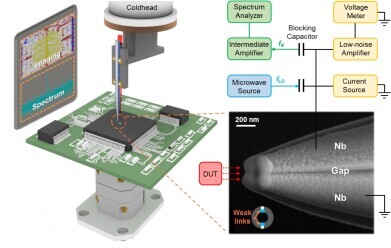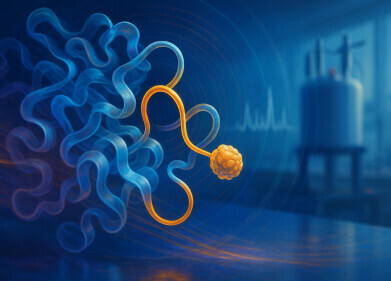-
 Schematic diagram of Josephson microscope. Credit: ©Science China Press
Schematic diagram of Josephson microscope. Credit: ©Science China Press
Microscopy & microtechniques
Ultra-broadband near-field Josephson microwave microscopy
Mar 31 2025
Modern microwave technology, including the generation, manipulation, and detection of microwaves, plays a vital role in various fields, such as high-frequency integrated circuits, quantum computing and microwave photonics. To achieve optimal performance of microwave devices, it is necessary to detect the spatially resolved microwave properties to analyse microwave interactions, promote efficient signal coupling, and address challenges including electromagnetic compatibility and signal crosstalk.
Several microwave imaging techniques have been developed, including scanning near-field microwave microscopy (SNMM), nitrogen-vacancy (NV) centre microscopy, atomic vapor cell microscopy, etc. However, none of these techniques can balance sensitivity, resolution and bias magnetic fields satisfactorily.
Josephson junction is a basic structure consisting of two superconductors separated by a barrier layer, which is an important device in superconducting electronics. It includes various configurations such as weak links, sandwich layers, point contacts, etc. The strong nonlinear characteristics can be used as a mixer, exhibiting extremely high sensitivity – approaching the quantum noise limit – to microwaves.
When the microwave frequency is higher than the characteristic frequency of Josephson junctions, the device can function as a bolometer, capable of detecting single microwave photons. Thus, fabricating nanoscale Josephson junctions provides a new solution for near-field microwave detection and imaging.
A team led by Professor Peiheng Wu, of the Research Institute of Superconductor Electronics, Nanjing University, China have successfully developed a superconducting Josephson probe microscope, dedicated to near-field microwave spectroscopic imaging. This new microscope combines the sensitivity of Josephson junctions microwave detection with the high spatial resolution of scanning probe microscopy.
The Josephson probe microscope offers an ultra-broadband, highly sensitive, and high-resolution solution to near-field electromagnetic characterisation and imaging for microwave chips with frequency ranging from microwave to millimetre-wave. It enables a variety of functionalities, including microwave detections of intensity, spectrum and frequency-selective imaging.
It is expected that this microscope would play an important role in research, including high-frequency integrated circuits, quantum computing, and magnonics.
The research team developed the core component of the microscope system – the Josephson probe. The probe fabricated with weak-link Josephson junctions onto the nanoscale quartz tip was produced by employing grooved quartz tube drawing technology and a multi-angle evaporation process, which overcomes the weak directionality of magnetron sputtering. The research team observed clear Shapiro steps from the nanoscale Josephson probe under microwave irradiation which confirmed the Josephson effects.
Furthermore, based on the microwave-voltage response and noise spectral characteristics, the team confirmed that the probe has high microwave sensitivity. They also demonstrated ultra-broadband coherent detection by utilising the highly nonlinearity of the Josephson probe. Through the signal mixing effect between local oscillations and radio frequency inputs, the unknown microwave signals can be measured from the spectra, with a frequency resolution of kHz level, as well as with a frequency range from 1 GHz to 200 GHz.
Using this Josephson probe the team developed a near-field microscope system for spatial-resolved microwave imaging. They successfully examined standing waves in coplanar waveguides and ring-shaped microwave distributions in voltage-controlled oscillator chips.
The spatial resolution of such microscopes is sub-micrometre level, with the potential for further improvement in future. The Josephson probe microscope exhibits excellent performance at low temperatures, providing an in-situ and non-destructive imaging tool for ultra-low-temperature quantum technologies.
The team’s article: ‘Ultra-broadband near-field Josephson microwave microscopy’ was published in the 2024 issue of: National Science Review. Dr. Ping Zhang is the first author of this work, with Dr. Yang-Yang Lyu, Professor Yong-Lei Wang, and Professor Huabing Wang are co-corresponding authors.
For further reading please visit: 10.1093/nsr/nwae308
Digital Edition
Lab Asia Dec 2025
December 2025
Chromatography Articles- Cutting-edge sample preparation tools help laboratories to stay ahead of the curveMass Spectrometry & Spectroscopy Articles- Unlocking the complexity of metabolomics: Pushi...
View all digital editions
Events
Jan 21 2026 Tokyo, Japan
Jan 28 2026 Tokyo, Japan
Jan 29 2026 New Delhi, India
Feb 07 2026 Boston, MA, USA
Asia Pharma Expo/Asia Lab Expo
Feb 12 2026 Dhaka, Bangladesh
.jpg)
-(2).jpg)
















